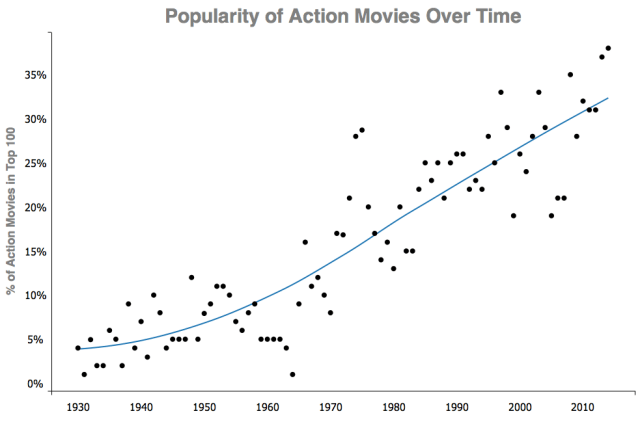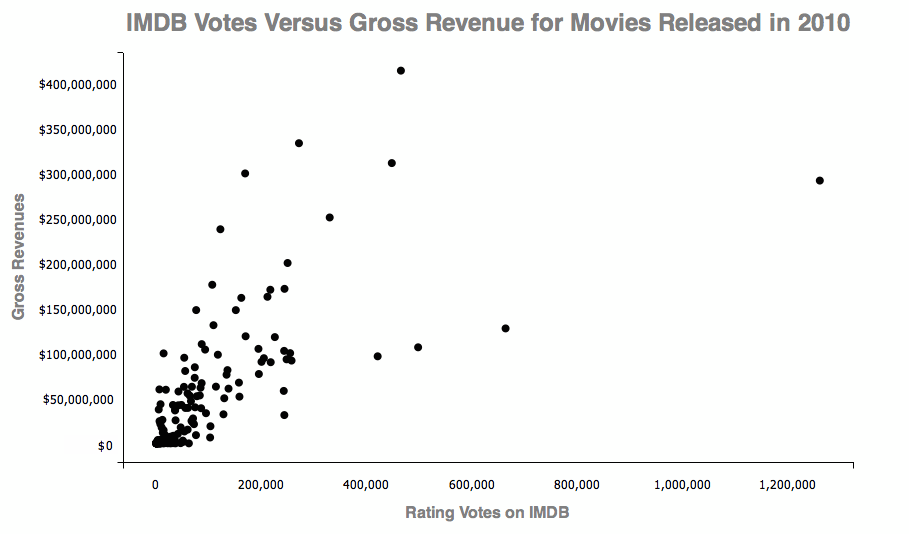
Dan Kopf, Priceonomics; Data: IMDB
Action movies date back to the earliest days of film, but they haven’t always been as popular as they are today. In the 1930s, when modern Hollywood came to life, only a small fraction of the most popular American movies were part of the action genre as tagged by the Internet Movie Database (IMDB).
How things have changed. The last 80 years have witnessed the action genre’s inexorable rise. Action movies, which made up just 4% of the top films in the 1930s, encompassed over 34% of films thus far in the 2010s. Though it is difficult to isolate the causes of this growth, researchers and industry participants theorize that the increasing affordability of special effects, and the desire to appeal to a more global audience, played a large part.
We discovered the action genre’s ascendence by looking at the data catalogued on IMDB. We analyzed the 100 most popular feature films in every year, by most votes on IMDB, made in the United States from 1930 to 2014. IMDB assigns each movie a genre or multiple genres, so we were able to look at which types of films have become more common through the years.
In addition to the action movie’s striking boom, we also found interesting patterns in the history of the popularity of the comedy and horror genres. The popularity of horror movies peaked in the 1980s and have slowly descended in popularity since. Comedies were initially very popular, but their prevalence have been quite uneven across time.
Trends for the Most Common Genres
The chart below displays the popularity of the 5 most common genres in American film since 1930. Those trend lines are smoothed fits based on the percentage of the top 100 movies in each year that were in that genre.
We can see that the number of popular movies that fall into “drama” decreased relatively quickly from 1930-1975, and held more or less steady from 1975 onwards. “Comedy” (in red) has had a more topsy-turvy ride. And “action” (blue), has been climbing steadily since the birth of Hollywood.

Dan Kopf, Priceonomics; Data: IMDB
The above chart may look different from other charts on this same subject. A popular chart from 2012 also looking at genre change appears quite different due to their inclusion of all movies in IMDB without filter on country or popularity, and because they assigned movies that had been cross-listed in different genres to only one genre.
Most movies on IMDB fall into more than one genre. In fact, 83% of the films in our dataset are assigned to more than one genre. American Sniper, for example, is assigned 6: action, biography, drama, history, thriller, and war. IMDB tags the animation movie “Big Hero 6” and the stunt documentary film “Jackass 3D” as part of the action genre because they contain action sequences. So perhaps it is more appropriate to think of those movies tagged as “action” movies on IMDB, not as Sly Stallone style action flicks, but rather as movies containing “action”.
As noted earlier, the chart is based on a dataset of the top 100 movies were chosen based on the number of votes in IMDB. This is a good proxy for popularity at the movie theater. The chart below shows the relationship between votes and revenues in 2010. Each point represents a movie. That outlier for votes, with over 1.2 million, is the action/sci-fi blockbuster “Inception”.

Dan Kopf, Priceonomics; Data: IMDB
The Rise of Action
The next chart displays, in more detail, the steady growth of the action genre in the most popular American movies by year. Each point is the number of action movies in the top 100 movies in that year, and the line is a smoothed fit of the trend. In every decade from 1940 to 2010, there were, on average, three more action movies in the top 100 than there were in the preceding decade.

Dan Kopf, Priceonomics; Data: IMDB
Action movies from 1940 look very different from action movies from 2014: movie magic has come a long way. Researchers from the University of Indiana, who also studied movie genre trends, observe that the genres that have increased in prevalence are the most technology intensive. According to them, the shift towards technology intensive movies, like action movies, occurred because those movies have become “relatively cheap to produce”. A technological innovation like Computer Generated Imagery (CGI) made including action cheaper — these days you don’t actually have to blow up an actual building, in order for a building to blow up in your movie — and thus leads a director/producer to choose to include an action sequence, when before it would have been an unjustifiable expense. And it’s made films that are mainly “action films” cheaper to produce overall.
Some industry insiders theorize that the rise of the action genre is related to globalization. They suggest that action and sci-fi movies translate better to a global audience, and that Hollywood is simply serving their new, larger constituency. The researchers from Indiana dispute this as a driving factor, claiming that the proportion of international revenues for American movies has not changed substantially over the last 40 years, during a period of major growth for action movies.
The Ups and Downs of Comedy and Horror
Unlike the continuously positive trend for action movies, the popularity of comedy has seen both highs and lows. In the 1930s, nearly 40% of popular movies were comedies. The average fell below 20% in the 1950s. Perhaps this was a symptom of the seriousness of America after World War II. Comedy films surged in popularity in the 1980s and 90s, the period of America’s first comedy boom, and have been on a slight decline since. Perhaps the second comedy boom, supposedly happening now, will lead to another upswing.

Dan Kopf, Priceonomics; Data: IMDB
Like action, horror was not a large part of popular American cinema during the 1930s. Fewer than 5% of popular movies were part of the horror genre in the 1930s but they steadily grew in popularity, reaching a high water mark in 1981, when 29 of the top 100 films were classified as horror (including Friday the 13th Part 2 and The Howling). Since that peak in the 1980s, horror’s popularity has slowly receded.

Dan Kopf, Priceonomics; Data: IMDB
***
Our analysis of the most popular genres of movies across time demonstrates the fluidity of American popular film. As tastes and technology has changed, so have the kinds of movies that were made. But while the prevalence of some genres have had peaks and valley, the trend for action movies has been an undeviating ascent.
![]()
This post was written by Dan Kopf; follow him on Twitter here. To get occasional notifications when we write blog posts, please sign up for our email list.



